 |
Latest Pleistocene
through Holocene Volcanism in Central Mongolia
and Northeast China: Partial Melting in Closed
and Open Mantle Sources
|
Irina S. Chuvashovaa, J.
Liub,
S.V. Rasskazova, F. Mengb, T.A.
Yasnyginaa, N.N. Fefelova & E.V.
Saraninaa
aInstitute of the Earth's
Crust, Siberian Branch, Russian Academy of Sciences,
Irkutsk, Russia
bInstitute of Geology and Geophysics,
Chinese Academy of Sciences, Beijing, China
Corresponding author: chuvashova@crust.irk.ru
This webpage is a summary
of: Chuvashova et al., Holocene volcanism in Central
Mongolia and Northeast China: asynchronous decompressional
and fluid melting of the mantle, J.
Volc. Seis.,1, N 6,
372-396, 2007b.
Abstract
Volcanic eruptions in Central
Mongolia during the latest Pleistocene and Holocene
preceded an initial Holocene volcanic event of 8740 ± 400
BP in NE China and terminated simultaneously with
that event as inferred from 14C dating.
Alkaline magmatic material was erupted in Taryat,
Central Mongolia first along an EW line of volcanoes
and afterwards along a N-NE line. Partial melting
in a mantle source of 1.5–3.0%
was followed by increasing melting of up to 5%. Similar
material was erupted in Jingpohu,
NE China, 5430–4400 BP. Initial melting of ~2%
beneath the Frog Pool volcanic center and ~5% beneath
the Crater Forest volcanic line was followed by variable
melting beneath the latter. The final eruptions were
the products of ~5% partial melting. The liquids of
Central Mongolia and NE China were derived from closed
(homogeneous) and open (heterogeneous) mantle sources,
respectively. Unlike the former, the latter resulted
in wide variations in the isotopic compositions of
Sr, Nd, and Pb and their depletion in high-field-strength
elements (Nb, Ta, Ti).
We suggest that
the mantle magmatism of Central Mongolia and NE China
was governed by different mechanisms–adiabatic decompressional
melting in the former region and fluid-fluxed melting
in the latter. Decompressional melting resulted in
short-term syntectonic volcanic episodes at ca. 70-50
ka and 8.8 ka, whereas the fluid-fluxed melting characterized
the Holocene volcanic activity and was delayed relative
to the latest magma-generating tectonic event in Asia.
Introduction
This webpage is a contribution to
the plume debate in Asia. Hypotheses on the causes
of Cenozoic tectonic activity in Asia have a long history
of debate. In the late 1980s, the lower mantle beneath
this region was defined seismically as a high-velocity
region similar to that beneath North America (Castillo,
1988). This suggested that central Asia could be the
geodynamic opposite of SOPITA, the “South Pacific
Isotopic and Thermal Anomaly”, considered to
be underlain by low-velocity lower mantle, upwellings,
and multiple plumes (Staudigel et al., 1991).
Nevertheless, in the early 1990s, in spite of the major
differences, Morgan's innovative idea of convective
plumes in the lower mantle was arbitrarily transferred
to Asia to explain the diffuse Cenozoic magmatism there.
During the last decade, however, evidence
has been presented relating this magmatism to upper
mantle processes only. The significance of shallow-mantle
magmatic sources has been emphasized for central Mongolia, e.g. by Barry
et al. (2003, 2007), Rasskazov et al. (2003) and Bayasgalan
et al. (2005).
High-resolution tomography from surface-wave
data (Yanovskaya & Kozhevnikov, 2003)
has revealed velocity variations including the Transbaikalian
low-velocity domain (200-350 km depth) and
the Sayan–Mongolian,
Okhotsk Sea, and Philippine Sea low-velocity domains
(50-200 km depth). The Transbaikalian domain
appears to be related to Late Phanerozoic subduction
of oceanic plates beneath East Asia. The Sayan–Mongolian
domain also could originate from long-term geological
processes but it was obviously influenced by Cenozoic
processes connected with Indo-Asian collision (Rasskazov
et al., 2003; Rasskazov & Taniguchi,
2006). We reported the results of a comparative
study of the youngest volcanic rocks from Central Mongolia
(Taryat) and NE China (Jingpohu and Wudalianchi; Chuvashova
et al., 2007b). Place names used in this webpage
are shown in Figure 1.
The volcanic areas of NE China are
in front of the currently active Pacific slab, which
is subducted beneath Eurasia. A stagnant
slab is known to exist there as a high-velocity anomaly
in the mantle transition zone at depths of 410–660
km (Fukao
et al.,
1992). The NW edge of the high-velocity anomaly
is advanced inland relative to the Pogranichny gravity
step of East Asia by ~ 300 km. Wudalianchi
is immediately E of the Pogranichny
gravity step, and Jingpohu and Changbaishan are
closer to the continental margin (Figure 1). The goal
of this webpage is to define the main features
of coeval deep-seated magmatism in the latest
Pleistocene and Holocene in Central Mongolia and NE
China.
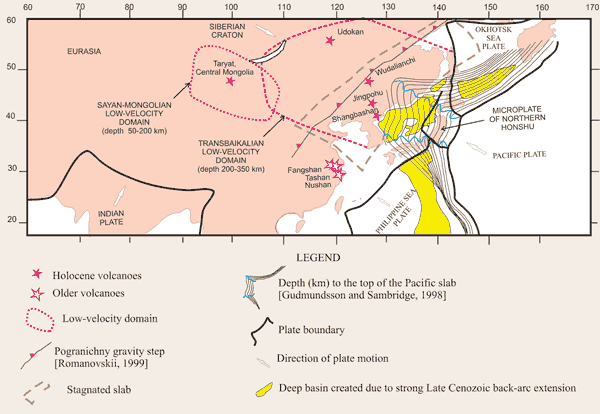
Late Pleistocene through Holocene
volcanism in the Udokan Range, N Transbaikal
is well dated by 14C (Rasskazov, 1999).
Thus we use this area as a standard for
comparative studies of late volcanism elsewhere (Figure
2).
The Trachytovyi and Syni volcanoes
that were active 14,400-9,800 BP discharged magma through
NW-SE fissures and the Dolinnyi, Aku, and
Chepe volcanoes which were active ca. 8,800-2,200 BP.
The direction of crustal extension changed at
~ 8,800 BP.
The upper time limit for the discharge
of lava flows in Taryat is defined by 14C dating
of organic material from the lacustrine sediments
overlying the lavas: 4,930 ± 150 BP (Logachev
et al., 1982)
and 6,890 ± 400 BP (Devyatkin, 2004).
The eruptions themselves have not been dated.
Their timing is estimated by assuming that the rearrangement
of Holocene volcanic zones in Taryat and Udokan occurred
simultaneously. The lower time limit for the Khorgo
eruption and the flows that flooded
the area is taken to be the eruption time of Dolinnyi
Volcano, which marks the structural
rearrangement of the Udokan volcanic zone at 8,780 ± 260
BP. It seems Khorgo Volcano erupted 8780–7710
BP. Eruptions on the EW volcanic line in Taryat are
compared to earlier eruptions in the Udokan
Range 14,400–9,800 BP.
According to disequilibrium U-Th dating, eruptions
of Odnobokii, Listvennichnyi, and Sosnovyi volcanoes
occurred 70-50 ka (Chuvashova
et al., 2007a; Rasskazov
et al., 2008).
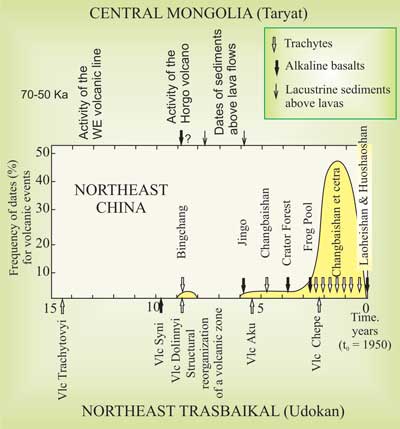
Figure 2: Temporal relations
between volcanic eruptions in NE Transbaikal, Central
Mongolia, and NE China (14C
calibrated ages).
Forty-four volcanic events were defined
in NE China based on archival records of historical
eruptions and
14C ages. The earliest eruption of trachyte
pumice from Bingchang Volcano in southern Jilin Province
occurred at 7,854 ± 180
BP (Zhang et al., 1996), the same as Dolinnyi
volcano. The latter was also trachytic pumice.
Holocene volcanism in NE China began simultaneously
with structural reorganization of the Udokan volcanic
zone.
In Jingo, Jingpohu, and Changbaishan
volcanoes, eruptions occurred 5,910–4,400
BP. The 14C date for the former is 5,140
BP (Zhang
et al., 1991). The Crater Forest line in the Jingpohu
area has three 14C dates: 4,630 ± 60
BP for the northern end of the line and 3,950 ± 70
and 3,970 ± 70 BP the central
part. A 14C date of 4,460 ± 80 BP
was obtained for Frog Pool volcanic center (Zhang
et al., 2002). The eruption time of Frog Pool
volcanic center is thus comparable to that of the northern
Crater Forest line.
Jingpohu volcanism occurred
in three cycles. The first and second
occurred in the Crater Forest line and
Frog Pool volcanic center, while the third was confined
to the Forest line (Zhang et al., 2002).
A date of 4,105 ± 90 BP was obtained for trachyte
pumice N of Changbaishan
Volcano (Liu & Taniguchi, 2001). The interval
of volcanic activity in NE China, 5,910–4,400
BP, is comparable to the eruption of trachyte
ffrom Aku volcano in the Udokan Range. For later eruptions
at Changbaishan Volcano, 22 14C dates
gave a total age range of 2,420 ± 95 to
910 ± 45
BP. There are historical records of eruptions
on Changbaishan, with the last event in 1903. A magma
chamber was detected by electromagnetic soundings and
S-wave recordings at 15–25 km depth beneath Tianchi
Crater (Liu & Taniguchi, 2001).
The beginning of frequent activity in Changbaishan
was approximately simultaneous with an eruption of
Chepe Volcano in Udokan.
In addition to similar trachyte
compositions of pumice in the Holocene volcanoes of
NE China and NE Transbaikal, the approximately simultaneous
resumption of volcanic activity in these regions since
ca. 7,780–7,740
BP is noteworthy. One difference occurred from 2,500–2,200
BP; unlike the Udokan volcanism, which terminated with
eruption in Chepe Volcano, Changbaishan volcano entered
a phase of frequent activity that continues to the
present day. Recent activity in Wudalianchi was
recorded in Laoheishan and Huoshaoshan volcanoes.
According to historical Manchu archives, the former
became active January 14, 1720, and ceased erupting
before the end of March 1721. The latter began
erupting in April 26 and ceased in June, 1721 (Liu & Taniguchi, 2001).
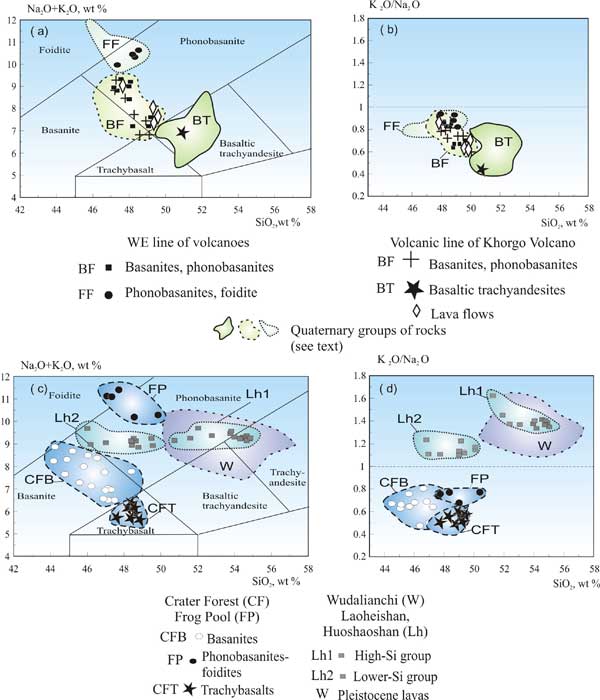
Figure 3: Na2O+K2O
and K2O/Na2O
versus SiO2 in volcanic rocks from Central
Mongolia (a, b) and NE China (c, d). Data sources
for c and d: Hsu et al. (1998), Wang et al. (1996),
Zhang et al. (1995), Zhang et al. (2002), and Zou
et al. (2003). Dividing lines in a and b are shown
according to the IUGS classification. The compositions
have been recalculated to 100% on awater-free basis.
The Quaternary volcanic rocks of Taryat consist mostly
of basanites, phonobasanites, basaltic trachyandesites,
phonobasanites and foidites (Figure 2). The lower
limit of the Quaternary volcanic sequence with elevated
87Sr/86Sr ratios (0.7052–0.7053; Chuvashova
et al., 2006) is 1.9 Ma
lavas.
Values of the Mg# = Mg/(Mg + Fe2+)
are generally higher in the basanite-phonobasanite
group than in the phonobasanite-foidite and basaltic
trachyandesite groups. The concentration of Ba in all
three groups varies within 500–800 ppm.
Zr is lower in the basaltic trachyandesites
than in the basanite-phonobasanite group and higher
in the phonobasanite-foidite group.
Variations of major elements in Jingpohu
and Taryat lavas are similar (Chuvashova
et al., 2007b).
The volcanic rocks of Crater Forest range from foidites
to trachybasalts, with lower SiO2 than
Taryat rocks. The phonobasanite-foidite group from
Frog Pool is comparable with that of Taryat. The K2O/Na2O
ratio in Jingpohu rocks varies from 0.47 to 0.80 and
overlaps the range found in Taryat rocks. The Mg# (60.8–67.0)
is elevated in Crater Forest basanites and decreases
to 59.3–61.4 in the trachybasalts. It is as low
as 47.1–49.1 in the Frog Pool
phonobasanite-foidites group. The Jingpohu volcanic
rocks have comparable Ba to the Taryat rocks. Volcanic
rocks from Wudalianchi have different
major and trace-element characteristics from
Taryat and Jingpohu rocks.
Unlike Central Mongolia, rocks
from NE China correlate poorly in trace elements. Elements
such as Rb, Ba, K, U, Ta, Sr, and Nb display significant
differences from La. Strong trace-element variations
suggest different magmatic sources. This is of particular
interest for Laoheishan and Huoshaoshan volcanoes
which yield specific compositions uncharacteristic
of the earlier Quaternary volcanism in Wudalianchi.
With the homogeneous trace-element
data for Taryat melts, we obtained reliable direct
and inverse modeling results for equilibrium partial
melting. We also calculated a model of fractional partial
melting using equations of Shaw (1970). The
direct equilibrium modeling, consistent with the results
of the inverse modeling, yield a composition of a metasomatized
mantle source containing olivine (41%), orthopyroxene
(20%), clinopyroxene (30%), garnet (5%), phlogopite
(3.4%), ilmenite (0.5%), and apatite (0.1%). The results
are illustrated in the (La/Yb)N vs. YbN diagram
(Figure 4a). The phonobasanite-foidite group from the
EW volcanic line resulted from 1.5–2.0% partial
melting. Some basanite and phonobasanite melts are
produced by higher degree of melting, but do not exceed
3.0%. The melts of the N–NE volcanic line belong
to the same mantle source but with higher degrees of
partial melting (2.0–2.5%), except for two
points that fall in the interval 5–10%. The higher
Yb concentrations in the basaltic trachyandesite from
Khorgo crater suggest
garnet content in the mantle source decreasing from
5 to 3%. This degree of melting is
comparable to that of the Khorgo line.
Direct modeling shows that the Jingpohu
rocks came partly from a similar source to the Taryat
rocks. The Crater Forest basanites
mostly lie along the line of the source with garnet
concentration 5% at degrees of melting 2–5%.
Unlike the Taryat source, the Jingpohu source lacks
ilmenite. The Crater Forest trachybasalts were derived
by melting approximately 5% of the mantle source with
3% garnet, similar to the basaltic trachyandesite from
Khorgo Volcano.
Some Jingpohu rocks show low Yb concentrations.
These belong to the phonobasanite-foidite group of
the first and second cycles of activity of Frog
Pool volcanic center. Such sources had a garnet concentration
of ca. 8%. According to the equilibrium melting model,
partial melts produced during the first eruptive cycle
were ~ 2% beneath Frog Pool Volcano and ~ 5% beneath
the Crater Forest line. During the second eruptive
cycle, the degree of melting beneath Frog Pool remained
the same, while varying between 2 and 5% beneath Crater
Forest. During the third eruptive cycle, the degree
of melting beneath Crater Forest increased to 5%, with
garnet concentrations between 3% and 8%.
The equilibrium melting model assumes
variations at the source of Wudalianchi Quaternary
melts of garnet concentration 5-8% at melting degrees
of 0.5 - 1.8%. Laoheishan and Huoshaoshan
volcanoes correspond to garnet
concentrations of ~ 5%.
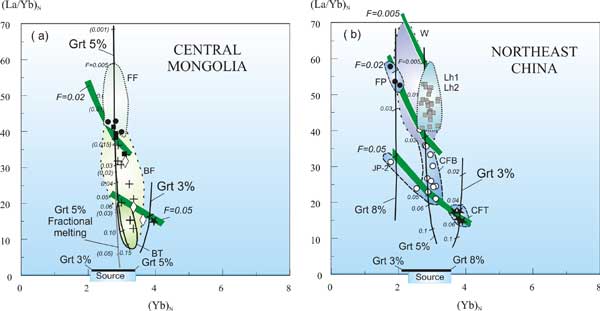
Figure 4: (La/Yb)N
versus (Yb)N in volcanic rocks from (a) Central Mongolia,
and (b) NE China. The
calculated lines of partial melting for sources with
varying garnet abundances are shown. The compositions
have been normalized to undifferentiated mantle
(McDonough & Sun,
1995).
Interpretation
Strong collision-related compressive
stresses affect the lithosphere of Central Mongolia
and the southwestern Baikal Rift System and are expressed
in volcanic episodes. In intra-continental areas and
the E and S convergent zones of Asia, volcanic episodes
were not coeval 2.0–1.5 Ma but synchronized
subsequent to ca. 1.2 Ma. This change marks a transition
from independent to closely connected interplate and
within-plate processes (Rasskazov et al., 2000).
Melts from the isotopically-rich magma
source (87Sr/87Sr
0.7052–0.7053) that erupted in Taryat at ca.
1.9 Ma were followed by melts with enriched
compositions (87Sr/87Sr, 0.7046–0.7047)
and varying Sr content (625-2000 ppm).
The increasing Sr abundance from the basaltic trachyandesite
group through the phonobasanite-foidite
group, with concurrently increasing (La/Yb)N,
indicates that it enriches low-volume partial melts.
The fixed values of 87Sr/87Sr at varying degrees
of partial melting reflect the source homogeneity and
not the involvement of components from other
sources.
Liquid evolution can be
explained by melting a local mantle volume by syntectonic
adiabatic decompression. Melting
results from the movement of material to a region
of lower pressure. During the last 1.2 Ma, the collision-related
tectonic regime favored multiple eruptions in the Taryat
basin controlled by EW-trending tectonics with sinistral
strike-slip
displacement. This zone extended for over 80 km. The
strike-slip
regime alternated with increasing extension in a
direction orthogonal to the collision-derived stress.
EW conduits discharged magma with a low degree
of partial melting (1.5–3%) and a north–NE
conduit with higher degree (up to 5%).
Lavas of the Laoheishan and Huoshaoshan
volcanoes show an excess of 230Th relative
to 238U (230Th/238U
= 1.24–1.33).
The increase of 230Th/232Th
with increasing K2O and
87Sr/87Sr and decreasing
143Nd/144Nd and 206Pb/204Pb
suggests isotopic and elemental heterogeneity of the
mantle source during the last ~ 350 ka.
Garnet peridotite and metasomatic materials were components.
The isotopic heterogeneity could
not be due to mixing of magma from two isolated
mantle regions. It resulted from transport of material
into the melting peridotites (Zou et al., 2003).
The lavas of Laoheishan and
Huoshaoshan volcanoes is comparable to the Quaternary
Wudalianchi lavas, while the presence of the Lh2 compositional
group, absent prior to the 1720–1721
eruptions, shows that the magmatism changed drastically
relative to the preceding Quaternary magmatism. Since
the data do not show any significant displacement
towards depleted sub-lithospheric mantle (Figure 5b),
any relationship between the special composition of
the Lh2 group and an increased supply of deeper material
is ruled out. The relatively decreasing role of garnet
(Figure 5b) indicates present-day generating liquids
in the upper part of the magmatic region.
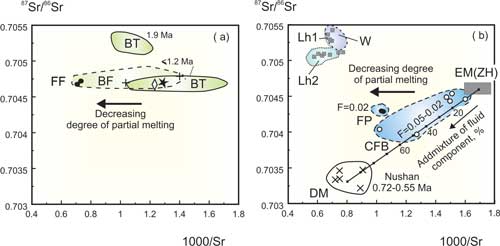
Figure 5: 87Sr/87Sr vs.
1000/Sr for volcanic rocks of central Mongolia and
NE China. For legend see Figure 3. (a) a basaltic
trachyandesite field (BT), 1.9 Ma. The decrease of
1000/Sr in volcanic rocks 1.2 Ma and younger is consistent
with decrease of the degree of partial melting at
the mantle source. (b) the components EM(ZH) - slightly
enriched Jingpohu mantle component, EM(W) - more
enriched Wudalianchi component, DM - depleted component
represented by the Nushan, Fangshan, and Tashan basalts.
Compositions of the Nushan lavas are shown by oblique
crosses, after Zou et al., (2000).
Temporal volcanic evolution in Wudalianchi
(Wang & Chen, 2005)
showed a change of sources with a key role
being played by the volcanoes Yoquanshan (K-Ar dates
1.33–0.93 Ma), Bijiashan (0.87–0.16
Ma) and Laoheishan and Huoshaoshan (final eruptions
1720–1721
AD). Based on new analytical results we found successive
melting of three mantle components: 1) initial, 2)
intermediate, and 3) final, exhibited by eruptions
with relatively high 87Sr/87Sr (0.705388–0.705402),
K2O (5.5–5.9 wt%), intermediate 87Sr/87Sr (0.705160–0.705211),
K2O (4.4–4.6 wt%), and lower 87Sr/87Sr (up
to 0.705054), K2O (up to 4.1 wt%), respectively.
During the 1720-1721 AD episode, mixing of the two
former components in lavas of the Laoheishan volcano
was followed with mixing of two latter ones in lavas
of the Huoshaoshan volcano (Figure 6).
Although the liquids of the Crater Forest and Khorgo
volcanic lines are similar in terms of composition
and degree of melting at the mantle source, the similarity
is incomplete. The depletion in high-field-strength
elements (Nb, Ta, Ti) shows that Jingpohu alkali lavas
were produced by melting of mantle rocks with the involvement
of aqueous fluids.
The isotopic heterogeneity of Jingpohu
alkaline basalts is expressed in the 87Sr/87Sr vs.
1000/Sr plot. Figure 5b shows a trend of data between
depleted and enriched mantle components. The former,
similar to the Nushan, Fangshan, and Tashan basalts
represents material of the sub-lithospheric mantle,
the latter, similar to the mantle component of Taryat,
exhibits the metasomatized garnet peridotite. The liquids
derived through the higher degree of partial melting
beneath the Crater Forest line fall at the mixing line,
whereas decreasing degree of partial melting is expressed
by a shift of points to the left. Taking into consideration
depletion of the Jingpohu volcanic rocks in high-field-strength
elements, we suggest that the isotopically-depleted
component was brought into the peridotite by aqueous
fluids. The Crater Forest rocks contain a 10 to 50%,
and the Frog Pool rocks 20–30%, admixture of
the isotopically depleted component.
In contrast to adiabatic decompression melting due to
the intrinsic heat of the system, the fluid fluxing mechanism
of melting in the mantle seems to favor sustained magma
generation.
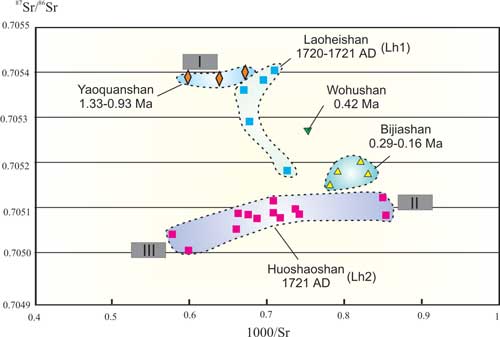
Figure 6: Source heterogeneity
in 87Sr/87Sr vs. 1000/Sr space
for volcanic rocks from Wudalianchi. I-III – mantle
components: I – initial, II – intermediate,
III - final. Data sources: Zhang et al. (1995), Zou
et al. (2003) and unpublished results of the authors
of this webpage.
Conclusions
-
Timings of
the latest Pleistocene through Holocene volcanic
eruptions in Central Mongolia, Northern Transbaikal,
and NE China show close links. We speculate
that the regular temporal relations of volcanic
events were governed by a common trigger, which
might be a strong tectonic pulse propagating from
the Indo-Asian collision zone. We connect the maximum
tectonic stress with structural reorganization
of the volcanic zone in Udokan, Northern Transbaikal
at 8,780 ± 260 BP. In Taryat, Central Mongolia
the volcanoes Odnobokii, Listvennichnyi, and Sosnovyi
of the EW volcanic line were active
at ca. 70-50 ka, i.e. before the reorganization,
while eruptions on the N-NE line of
Khorgo volcano and related flows occurred either
at the time of the structural reorganization or
shortly after. In NE China, Holocene volcanism
initiated at 8,740 ± 400 BP, i.e. simultaneous
with the structural reorganization in Udokan. The
frequency of eruptions increased in NE China at
about 2,500-2,200 BP, i.e. at the time of the latest
eruption in Udokan. Volcanic activity was constrained
in Jingpohu in the time interval 5,430–4,400
BP and was recorded in Wudalianchi in 1,720-1,721
AD.
-
Similar ranges of rock compositions
were found in Taryat, Central Mongolia and Jingpohu,
NE China. In the former area, the basanite-phonobasanite
group was sampled both in the EW and N–NE
volcanic lines. In addition, the phonobasanite-foidite
group was identified at the EW volcanic line and
the basaltic trachyandesite group in the N–NE
line. In the latter area, the early eruptions at
Frog Pool volcanic center were compositionally
similar to those from the EW volcanic line of Taryat,
whereas the later lavas from Crater Forest line
were similar to those from the N–NE line
of Taryat. The eruptions of Laoheishan and Huoshaoshan
volcanoes were characterized by high-K compositions
and other geochemical characteristics,
which are generally typical of the Middle Miocene
through Quaternary lavas from the Erkeshan, Wudalianchi
and Keluo volcanic fields.
-
Both in Central Mongolia and
NE China, magmatic liquids appear to be derived
from metasomatized garnet-bearing peridotite sources
located at depths of 80-120 km. Magma generation
in the former region was dominated by a single
homogeneous source and in the latter by
mixing of different components. Volcanic rocks
from Central Mongolia have high
correlation coefficients for incompatible elements
and narrow isotopic compositions of Sr both
for the Quaternary and latest Pleistocene through
Holocene units. Thus, the latest Pleistocene through
Holocene lavas discharged from the mantle source
that developed as a closed system since ca. 1.2
Ma. In contrast, volcanic rocks from NE China have
poor correlation between incompatible trace elements
and wide variations of 87Sr/87Sr, 143Nd/144Nd,
and 206Pb/204Pb. This heterogeneity
indicates melting in an open magmatic system
with the involvement of geochemically different
components. The apparent geochemical changes of
the melt occurred during eruptions of the Holocene
volcanoes both in Jingpohu and Wudalianchi.
-
Unlike the rocks from Central
Mongolia, those from NE China are depleted in high-field-strength
elements (Nb, Ta, Ti). Liquids of the former region
were generated by adiabatic decompressional melting,
while those of the latter were produced by the
additional effect of aqueous fluids. The decompressional
melting mechanism hypothesis is based on the definite
structural control of volcanic activity in Taryat
first by strike-slip movement in the EW zone, as
a direct reaction to increased tectonic stress
from the Indo-Asian collision zone, and then by
orthogonal extension relative to collision-derived
compression. Accordingly, deep adiabatic decompression
resulted in initial small-degree of partial melting
in mantle peridotite (1.5–3.0%)
and subsequent increased melting up to 5%. Magma
generation via fluid fluxing began in NE China
subsequent to the structural reorganization. The
volcanic eruptions in Jingpohu occurred at the
advanced stage of Holocene magmatic evolution in
NE China and exhibited initial melting of approximately
2% beneath Frog Pool volcanic center, along
with increased partial melting and subsequent
overall increase in melting up to 5% beneath
Crater Forest line. Volcanic eruptions in Wudalianchi
reflected more delayed magmatic processes.
References
-
Barry T.L., Saunders A.D., Kempton
P.D. et al. Petrogenesis of Cenozoic basalts from
Mongolia: evidence for the role of asthenospheric
vs. metasomatized lithospheric mantle sources, J.
Petrol., 44,
55–91, 2003.
-
Barry T.L., Ivanov A.V., Rasskazov
S.V. et al. Helium isotopes provide no evidence
for deep mantle involvement in widespread Cenozoic
volcanism across Central Asia, Lithos, 95,
415–424, 2007.
-
Bayasgalan A., Jackson J., and McKenzie D. Lithosphere
rheology and active tectonics in Mongolia: relations
between earthquake source parameters, gravity and
GPS measurements, J. Geophys., 163,
1151-1179, 2005.
-
Castillo P. The Dupal anomaly
as a trace of the upwelling lower mantle, Nature, 336,
667-670, 1988.
-
Chuvashova, I.S., Rasskazov, S.V., Brandt, I.S.
et al., Isotope geochemical characteristics of different-age
late Cenozoic volcanic rocks in the Taryat Basin,
Central Mongolia, in Isotope Dating of Mineralization,
Magmatism, Sedimentation, and Metamorphism. Proc.
III Russian Conf. on Isotope Geochronology, Moscow:
GEOS, 2, 401–405, 2006.
-
Chuvashova, I.S., Zhuchenko, N.A., Stepanova, O.G.
et al., The first data on isotopes of 238U series
in volcanic rocks of the latest Pleistocene through
Holocene in Central Mongolia and Eastern Sayans, XVIII
Symposium on Isotope Geochemistry dedicated to the
Academician A.P. Vinogradov, Abstracts, Moscow,
281-282, 2007a. (in Russian)
- Chuvashova,
I.S., Rasskazov, S.V., Yasnygina, T.A. et al.,
Holocene volcanism in Central Mongolia and NE China:
asynchronous decompressional and fluid melting
of the mantle, J. Volc. Seismol., 1,
372-396, 2007b.
-
Devyatkin, E.V., The geochronology
of mongolian Cenozoic basalts and their relation
to neotectonic features, Stratigrafiya. Geol.
Korrelyatsiya, 12,
102–114, 2004. (in Russian)
-
Fukao, Y., Obayashi, M., Inoue, H. et al., Subducting
slabs stagnant in the mantle transition zone, J. Geophys. Res., 97,
4809–4822, 1992.
-
Hsu, C.-H. and Chen, J-C., Geochemistry of late
Cenozoic basalts from Wudalianchi and Jingpohu areas,
Heilongiang Province, NE China, J. Asian Earth
Sci., 16, 385–405,
1998.
-
Liu, J. and Taniguchi, H., Active volcanoes in
China, NE Asian Studies, 6,
173–189, 2001.
-
Logachev, N.A., Devyatkin, E.V., Malaeva, E.M.
et al., Cenozoic sediments in the Taryat Basin and
in the Chulutu R. Valley, Central Khangai, Izv. AN
SSSR. Ser. Geol., 76–86, 1982. (in
Russian)
-
McDonough, W.F. and Sun, S.-S.,
The composition of the Earth, Chem. Geol., 120,
223–253, 1995.
-
-
Rasskazov, S. and Taniguchi, H. Magmatic response
to the Late Phanerozoic plate subduction beneath
East Asia / CNEAS Monograph Series No. 21. Sendai:
Tohoku University - Institute of the Earth’s
crust, 156 pp., 2006.
-
Rasskazov, S.V., Brandt, S.B., Brandt, I.S. et
al., Radiogenic isotope geology in problems and examples,
Novosibirsk: GEO, 268 pp., 2005. (in Russian)
-
Rasskazov, S., Chebykin, E.,
Chuvashova, I. et al., Isotope disequilibrium of
238U-series in latest Pleistocene through Holocene
volcanic rocks from Hangay, Central Mongolia and
Eastern Sayans, Siberia, Geophys.
Res. Abs., 10,
04872, 2008. SRef-ID: 1607-7962/gra/EGU2008-A-04872.
-
Rasskazov, S.V., Logachev, N.A., Brandt, I.S. et
al., Late Cenozoic geochronology and geodynamics:
Southern Siberia, South and East Asia, Novosibirsk: VO
Nauka, 2000. (in Russian)
-
Rasskazov, S.V., Logachev, N.A., Kozhevnikov, V.M.
et al., Stage dynamics in the upper mantle of East
Asia: relationships between migrating volcanism and
low-velocity anomalies, Doklady Earth Sciences, 390,
492-496, 2003.
-
-
Romanovsky, N.P., The Pacific
segment of the Earth: Deep structure, granitoid
ore–magma systems,
Khabarovsk: ITiG DVO RAN, 1999.
-
Shaw, D.M., Trace element fractionation during
anatexis, Geochim. Cosmochim. Acta, 34,
237–243, 1970.
-
Staudigel H., Park K.-H., Pringle
M. et al. The longevity of the South Pacific isotopic
and thermal anomaly, Earth
Planet. Sci. Lett., 102,
24-44, 1991.
-
Wang, Y., Chen, H. Tectonic
controls on the Pleistocene–Holocene
Wudalianchi volcanic field (NE China), J.
Asian Earth Sciences, 24,
419–431,
2005.
-
Wang, Y., Mu, L., and Liu, W.,
Regularity and characteristic of volcanic activity
at Wudalianchi, Heilongjiang, Proc. 30th Intern. Geol. Congr., Beijing,
China, 14 pp., 1996.
-
Yanovskaya, T.B. and Kozhevnikov,
V.M., 3D S-wave velocity pattern in the upper mantle
beneath the continent of Asia from Rayleigh wave
data, Phys.
Earth Planet. Int., 138,
263–278, 2003.
-
Zhang, Y., Quaternary volcanic
activity in China, in The
Quaternary of China, Beijing: Science Press,
274–306, 1991.
-
Zhang, M., Suddaby, P., Thompson,
R.N. et al., Potassic rocks in NE China: geochemical
constraints on mantle source and magma genesis, J.
Pet., 36,
1275–1303, 1995.
-
Zhang, C.L., The characteristics of Cenozoic distribution
in Jilin Province, in 30th Intern. Geol. Congr.,
Beijing, China, 10 pp. 1996.
-
Zhang, Z., Feng, C., Li, Z.
et al., Petrochemical study of the Jingpohu Holocene
alkali basaltic rocks, NE China, Geochem. J., 36,
133–153, 2002.
-
Zou, H., Zindler, A., Xu, X. et al., Major, trace
element, and Nd, Sr, and Pb isotope studies of Cenozoic
basalts in SE China: mantle sources, regional variations,
and tectonic significance, Chem. Geol., 171,
33–47, 2000.
-
Zou, H., Reid, M.R., Liu, Y. et
al., Constraints on the origin of historic potassic
basalts from NE China by U-Th disequilibrium data, Chem. Geol., 200,
189–201, 2003.
last updated 20th
November, 2008 |
